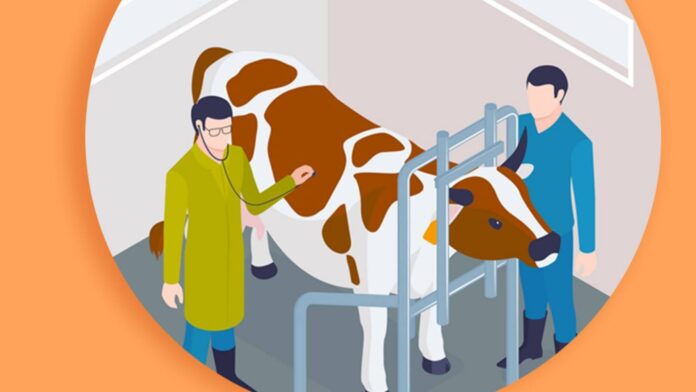CHALLENGES OF LIVESTOCK FARMING IN INDIA AND GOOD MANAGEMENT PRACTICES
INDRALE UTPALA ANNARAO AND TRUPTI SURYAKANT KATTIMANI
(VETERINARY OFFICERS DEPT OF AH&VS, GOVT OF KARNATAKA)
India has largest livestock population in the world. Livestock are source of subsidiary income for most of farmers. Livestock farming will produces regular source of income and generate employment in the rural India. Livestock are the moving bank for the farmers and they will address the economic stress of farmers. Livestock is the source of manure for Agriculture and fuel for domestic use. Livestock is backbone of farmers economy. Livestock are the source of income and employment generation. Livestock play important role as alternative source of income in case of crop failure and acts as insurance in famine conditions. Bullocks are backbone of agriculture. Urine and dung are the key components of organic farming. Livestock acts as natural weed-controlling agents. Milk, meat, egg will helps in the fight against malnutrition in rural parts of the country.
Challenges in Livestock Farming in India
Tropical environment
Due to very high environmental temperature and relative humidity will act as growth factor for Endecto-parasites whereas stress factor to animals leads to increased parasitic infestation, disease outbreaks and decline in animal health and production. Flood and famine conditions are directly affecting animal health and production ends with severe economic losses.
Shortage of feed and fodder
Due to urbanization and industrialization land availability for the cultivation and grazing for the livestock declines day by day. Commercial crops and non-agricultural usage of land causes shortage of fodder for animals.
Lower productivity
Indigenous livestock has lower performance in productivity, late maturation, and growth period. Lower genetic potential of native livestock leads to poor productivity.
Disease outbreak
Outbreak of livestock diseases occurs due to various factors. Disease outbreaks will causes higher morbidity causes increased treatment cost and mortality ends up with severe economic losses to farmers. Emerging diseases, resistance to medications and changes in climate pattern predisposes more disease outbreaks.
Labour shortage
Due to modernization culture urbanization and industrialization nobody want to work with animals. Agriculture and animal husbandry faces severe labour shortage in rural India, even labour shortage has become tough challenge for the ongoing farm activities and biggest challenge for the future of farming.
Unorganized market
Livestock products like milk, meat, egg are highly perishable commodities. Even market for wool, skin and other livestock bi-products is not satisfactory. Till today farmer will get paid less and consumer will pay more for the livestock commodities. Due to intervention of middle man farmers are facing challenges like low price, rejection of commodity and other issues.
Good management practices in Livestock Farming in India:
Ideal animal sheds with proper ventilation, grazing of animals in cool hours, regular deworming of both adults, periodical health check-ups, balanced feeding, and keeping of hygienic environment in the animal shed are key to success in livestock farming. Conservation of fodder, using alternative sources of fodders like Azolla, hydroponics, and straw enriched with urea and molasses will be helpful in drought conditions. Crossbreeding and upgradation of indigenous livestock breeds will improve productivity. Sexed semen and embryo transfer technology will enhance productivity in livestock. Proper sanitization and hygienic practices in the shed, quarantine, and bio-security measures, regular deworming, dipping, control of external parasites, vaccination and isolation, and prompt treatment of diseased animals will help in reducing the disease outbreaks in livestock. The practice of intensive farming, automation in farming, the use of skilled laborers, and the application of artificial intelligence and robotics will help to overcome the shortage of laborers. Initiatives like start-up programs, co-operatives, the application of deep freezer transport, and the creation of a chain link between producers and consumers will help in the creation of a market for livestock products.
Clean milk production, calf per year, balanced feeding, keeping of animals in a disease-free environment and ideal calf rearing are the basic steps of dairy farming. Control of Endecto parasites, regular deworming, and vaccination, feeding of coccidiostat and a hygienic environment in the shed are the important steps in Sheep and goat farming. Strict practices of bio-security measures, regular vaccination, optimum feeding, and seasonal management are key to success for backyard poultry.
Role of Veterinarians to Overcome Livestock Farming Challenges
Routine treatment, emergency treatment, doorstep service, and extension activities are the important activities of the veterinarian in the field condition. Training of farmers, organization of animal health camps, vaccination camps, extension talks, awareness talks on Radio and TV programs, writing of articles related to scientific farming in local languages will support the farmers for the livestock farming.


